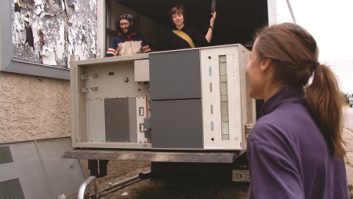The FCC should not ease its interference rules, even if those rules limit the number of low-power FM stations that can fit on the dial. That’s my conclusion after reading the reactions from the NAB and National Public Radio to a report from Mitre Corp. commissioned by the FCC.
Once allies on the LPFM issue, NAB and NPR are taking divergent approaches to the report, which suggests that more LPFMs could be allocated if third — adjacent — channel protections were dropped. NAB opposes that notion, while NPR seems to be straddling the fence.
In a filing of comments with the agency, NAB issued a scathing criticism of the Mitre report on the feasibility of the proposed low-power FM service. National Public Radio also had criticisms, but was qualified in its comments and generally supports the idea of trying to fit more LPFMs in the FM band.
NAB
NAB charges that the Mitre report wholly ignores two key congressional mandates — listening tests and an economic analysis on the impact on full — power FM stations. In passing the Radio Preservation Act of 2000, Congress instructed the FCC to conduct field tests to determine, in real-world conditions, whether LPFM stations would interfere with existing FMs if the low — power stations were not subject to third — adjacent-channel spacing requirements.
The NAB alleges that, due to cost considerations, Mitre used a single listener to judge whether harmful interference was present in the audio. Additionally, the NAB told the agency that the report does not include the “statutorily mandated economic analysis of the impact LPFM stations would have on full-power stations” were third — adjacent — channel requirements to be eliminated.
Technical flaws
The NAB asserts that the Mitre report is “replete with technical flaws.”
First, the “sample of one” listening test was not scientifically valid because it shunned properly designed subjective listening tests and relied on the judgment of a single individual.
Next, the NAB states that an understanding of a test receiver’s ability to accept or reject third — adjacent — channel interference is crucial. The trade association claims that Mitre failed to use a sufficient number of receivers and neglected to characterize the performance characteristics of the devices it did use. NAB then suggests that Mitre failed to test those receivers properly.
Finally, the association argues that the Mitre test site selection processes, driven by administrative convenience, was flawed and the selection of test locations was improper. The comments state that Mitre’s tests revealed that interference to full — power FM stations from third — adjacent-channel LPFM interference exists and is significant and that Mitre’s formulas for waving third — adjacent — channel distance restrictions have no basis in fact.
For these reasons, NAB argues that the commission cannot recommend to Congress the elimination of third-adjacent channel protections for LPFM service.
NPR
Although it too found flaws in the study, NPR came to a much different conclusion, recommending that the FCC allow experiments with LPFM.
While saying it agrees with the LPFM mission of producing and disseminating programming to unserved and under-served listeners, NPR filed comments expressing the view that the Mitre study suffers from significant methodological flaws. NPR feels that the public interest should not come at the expense of existing non-commercial educational services.
It is encouraged at the conclusions of the study, but NPR stated that “we are constrained to conclude, however, that the Mitre study’s methodology and testing were less than perfect.” NPR goes on to claim that Mitre and Comsearch “utilized a limited test bed of receivers and failed to establish through technical performance, sales volume, cost or other relevant factors that the chosen receivers were, in fact, representative of the universe of receivers now in common use.”
NPR found similar methodological flaws in the testing of third-adjacent interference to radio reading services; Comsearch tested only a single reading service.
Finally, NPR stated that “the imprecision of the interference perception and measurement methodology significantly obscured the nature and extent of the interference that the third-adjacent LPFM station likely caused.”
But, surprisingly, NPR does not come to the same conclusions as NAB and goes so far to state that it “believe(s) third — adjacent — channel LPFM stations might be authorized without causing undue interference, so long as certain safeguards are implemented.”
Another view
I agree with the NAB: the Mitre report is flawed. The report lacks the touch of experienced broadcast engineers in determining the true technical issues. The Mitre study neglects FCC policy in analyzing our system of FM radio broadcasting.
Like NAB, I feel that the LPFM proponents, including NPR and Mitre, ignore more than 50 years of FCC policy and long — established technical principals such as the effect of antenna height on FM — band signal propagation. For example, under the proposed LPFM system, I could design a legal LPFM site with much larger coverage area and interference zones than the Mitre report suggests, just by selecting a site with favorable HAAT characteristics.
The NAB position is more intellectually honest than the “cafeteria” approach of NPR, which “picks and chooses” the parts of the report it likes – despite its own admission that the study “suffers from significant methodological flaws.” Perhaps NPR sees an opportunity to distribute programming and increase audience size if more LPFM stations were on the air?
There is a clear, time-established principle that interference is bad for FM radio. To quote from the NAB comments, “Existing broadcasters have a legitimate expectation that they can and will reach their audiences … these listeners should not be deprived of their ability to receive free over-the-air service, including vital weather and other life-saving emergency information.”
If Congress and the FCC are serious about LPFM, they should start over and perform a scientifically rigorous test on the effects of third-adjacent interference.
RW welcomes other points of view.












